Summary:
Thrombotic microangiopathy (TMA) is a significant complication after hematopoietic stem-cell transplantation (HSCT); however, there is little information on it following reduced-intensity cord blood transplantation (RI-CBT). We reviewed the medical records of 123 adult patients who received RI-CBT at Toranomon Hospital between January 2002 and August 2004. TMA was diagnosed in seven patients based on intestinal biopsy (n=6) or autopsy results (n=1). While these patients showed some clinical symptoms such as diarrhea and/or abdominal pain, mental status alterations or neurological disorders were not observed in any of them. Laboratory results were mostly normal at the onset of TMA; >2% fragmented erythrocytes (n=1), <10 mg/dl haptoglobin (n=1), and >200 IU/dl lactic dehydrogenase (LD) (n=4). On endoscopic examination, TMA lesions, consisting of ulcers, erosions, and diffuse exfoliation, were distributed spottily from terminal ileum to rectum. Intestinal graft-versus-host disease (GVHD) and cytomegalovirus (CMV) colitis were confirmed in five and four patients, respectively. With therapeutic measures including supportive care (n=4), fresh frozen plasma (n=1), and a reduction of immunosuppressive agents (n=1), TMA improved in four patients. The present study demonstrates that intestinal TMA is a significant complication after RI-CBT. Since conventional diagnostic criteria can overlook TMA, its diagnosis requires careful examination of the gastrointestinal tract using endoscopy with biopsy.
This is a preview of subscription content, access via your institution
Access options
Subscribe to this journal
Receive 12 print issues and online access
$259.00 per year
only $21.58 per issue
Buy this article
- Purchase on Springer Link
- Instant access to full article PDF
Prices may be subject to local taxes which are calculated during checkout


Similar content being viewed by others
References
Shimoni A, Yeshurun M, Hardan I et al. Thrombotic microangiopathy after allogeneic stem cell transplantation in the era of reduced-intensity conditioning: the incidence is not reduced. Biol Blood Marrow Transplant 2004; 10: 484–493.
Nishida T, Hamaguchi M, Hirabayashi N et al. Intestinal thrombotic microangiopathy after allogeneic bone marrow transplantation: a clinical imitator of acute enteric graft-versus-host disease. Bone Marrow Transplant 2004; 33: 1143–1150.
Pettitt AR, Clark RE . Thrombotic microangiopathy following bone marrow transplantation. Bone Marrow Transplant 1994; 14: 495–504.
Zeigler ZR, Shadduck RK, Nemunaitis J et al. Bone marrow transplant-associated thrombotic microangiopathy: a case series. Bone Marrow Transplant 1995; 15: 247–253.
Zeigler ZR, Shadduck RK, Nath R et al. Pilot study of combined cryosupernatant and protein A immunoadsorption exchange in the treatment of grade 3–4 bone marrow transplant-associated thrombotic microangiopathy. Bone Marrow Transplant 1996; 17: 81–86.
Daly AS, Xenocostas A, Lipton JH . Transplantation-associated thrombotic microangiopathy: twenty-two years later. Bone Marrow Transplant 2002; 30: 709–715.
Zomas A, Saso R, Powles R et al. Red cell fragmentation (schistocytosis) after bone marrow transplantation. Bone Marrow Transplant 1998; 22: 777–780.
Barker JN, Weisdorf DJ, DeFor TE et al. Rapid and complete donor chimerism in adult recipients of unrelated donor umbilical cord blood transplantation after reduced-intensity conditioning. Blood 2003; 102: 1915–1919.
Miyakoshi S, Yuji K, Kami M et al. Successful engraftment after reduced-intensity umbilical cord blood transplantation for adult patients with advanced hematological diseases. Clin Cancer Res 2004; 10: 3586–3592.
Kodera Y, Morishima Y, Kato S et al. Analysis of 500 bone marrow transplants from unrelated donors (UR-BMT) facilitated by the Japan Marrow Donor Program: confirmation of UR-BMT as a standard therapy for patients with leukemia and aplastic anemia. Bone Marrow Transplant 1999; 24: 995–1003.
Nishihira H, Kato K, Isoyama K et al. The Japanese cord blood bank network experience with cord blood transplantation from unrelated donors for haematological malignancies: an evaluation of graft-versus-host disease prophylaxis. Br J Haematol 2003; 120: 516–522.
Allford SL, Bird JM, Marks DI . Thrombotic thrombocytopenic purpura following stem cell transplantation. Leuk Lymphoma 2002; 43: 1921–1926.
Furlan M, Robles R, Galbusera M et al. von Willebrand factor-cleaving protease in thrombotic thrombocytopenic purpura and the hemolytic-uremic syndrome. N Engl J Med 1998; 339: 1578–1584.
Trimarchi HM, Truong LD, Brennan S et al. FK506-associated thrombotic microangiopathy: report of two cases and review of the literature. Transplantation 1999; 67: 539–544.
Pham PT, Peng A, Wilkinson AH et al. Cyclosporine and tacrolimus-associated thrombotic microangiopathy. Am J Kidney Dis 2000; 36: 844–850.
Ballermann BJ . Endothelial cell activation. Kidney Int 1998; 53: 1810–1826.
Takatsuka H, Wakae T, Mori A et al. Endothelial damage caused by cytomegalovirus and human herpesvirus-6. Bone Marrow Transplant 2003; 31: 475–479.
Ertault-Daneshpouy M, Leboeuf C, Lemann M et al. Pericapillary hemorrhage as criterion of severe human digestive graft-versus-host disease. Blood 2004; 103: 4681–4684.
Goldberg J, Jacobsohn DA, Zahurak ML et al. Gastrointestinal toxicity from the preparative regimen is associated with an increased risk of graft-versus-host disease. Biol Blood Marrow Transplant 2005; 11: 101–107.
Iwata H, Kami M, Hori A et al. An autopsy-based retrospective study of secondary thrombotic thrombocytopenic purpura. Haematologica 2001; 86: 669–670.
Martin PJ, McDonald GB, Sanders JE et al. Increasingly frequent diagnosis of acute gastrointestinal graft-versus-host disease after allogeneic hematopoietic cell transplantation. Biol Blood Marrow Transplant 2004; 10: 320–327.
Iqbal N, Salzman D, Lazenby AJ, Wilcox CM . Diagnosis of gastrointestinal graft-versus-host disease. Am J Gastroenterol 2000; 95: 3034–3038.
Meyers JD, Flournoy N, Thomas ED . Risk factors for cytomegalovirus infection after human marrow transplantation. J Infect Dis 1986; 153: 478–488.
Acknowledgements
We are grateful to Dr Yoshihisa Morishita (JA Aichi Showa Hospital, Aichi, Japan) for his critical reading of the manuscript.
Author information
Authors and Affiliations
Corresponding author
Rights and permissions
About this article
Cite this article
Narimatsu, H., Kami, M., Hara, S. et al. Intestinal thrombotic microangiopathy following reduced-intensity umbilical cord blood transplantation. Bone Marrow Transplant 36, 517–523 (2005). https://doi.org/10.1038/sj.bmt.1705099
Received:
Accepted:
Published:
Issue Date:
DOI: https://doi.org/10.1038/sj.bmt.1705099
Keywords
This article is cited by
-
Comparison of multiple treatments in the management of transplant-related thrombotic microangiopathy: a network meta-analysis
Annals of Hematology (2023)
-
Multiple thrombosis associated with Cytomegalovirus enterocolitis in an immunocompetent patient: a case report
BMC Infectious Diseases (2021)
-
Intestinal thrombotic microangiopathy: a distinct entity in the spectrum of graft-versus-host disease
International Journal of Hematology (2019)
-
Intestinal thrombotic microangiopathy induced by FK506 in rats
Bone Marrow Transplantation (2007)
-
Successful second cord blood transplantation using fludarabine and cyclophosphamide as a preparative regimen for graft rejection following reduced-intensity cord blood transplantation
Bone Marrow Transplantation (2007)



